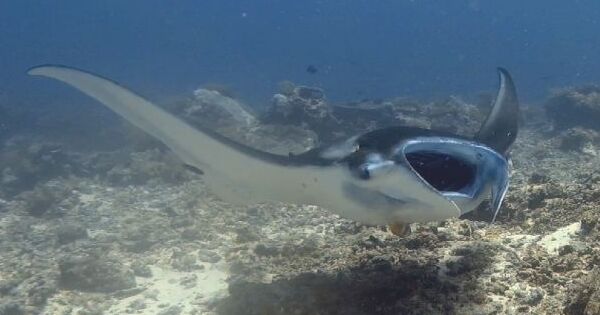Table of Contents
1) Why Diving In Komodo Is Among The Best In The World?
2) What Is The Best Time For Komodo Diving?
3) What Are The Challenges Of Diving In Komodo National Park?
4) Can Beginners Dive In Komodo?
5) What Marine Life Can You Expect In Komodo National Park?
6) What Art The Best Komodo Dive Sites?
7) Day Trips Or Diving Safaris?
8) How much is Diving in Komodo?
During September and October of 2022, I was incredibly fortunate to have the chance to explore the stunning underwater world of Komodo National Park on my own. Throughout these three weeks, I completed more than 30 dives on two different liveaboards and made multiple day trips. During the dives, I was able to experience the entire facet of the incredible underwater world of Komodo. From 10+ turtles in one dive to countless reef shark sightings to a school of 36(!) Mantas as “golden conclusion” in the second last dive in the Golden Passage, everything was there, and no wishes remained. Therefore, all my expectations were absolutely exceeded, and there are several moments I will never forget.
In this article, I will share everything you need to know about scuba diving in Komodo. Based on my personal experiences, I hope to give you valuable information and tips to make your diving trip to Komodo an unforgettable experience like mine.
Why Diving In Komodo Is Among The Best In The World?
Before my trip, I read a lot about Komodo in different diving magazines. After my trip, I totally understand why it is often considered one of the best diving destinations in the world.
Komodo can be found in the heart of the Coral Triangle, an area celebrated for its remarkable and diverse marine life. The underwater topography of Komodo is breathtaking, with dramatic pinnacles, walls, and slopes adorned with vibrant coral gardens.
The nutrient-rich waters of Komodo attract an astonishing variety of marine life. During my dives, I encountered creatures ranging from tiny macro critters like nudibranchs and pygmy seahorses to enormous pelagic species such as manta rays and sharks. Moreover, I never saw so many Giant Travellies (GTs) in my whole life. The sheer abundance of life is what sets Komodo apart from other diving destinations, making it, in my opinion, a must-visit for any diver.
The strong currents in Komodo also contribute to its incredible biodiversity. These currents result from the meeting of the Indian and Pacific Oceans, creating a unique marine environment that fosters the growth of coral reefs and attracts a plethora of marine life. While these currents can be challenging, they are in my option also part of what makes scuba diving in Komodo such an unforgettable experience. I will talk more later about the currents and my tips for beginners vs. advanced divers.
What Is The Best Time For Komodo Diving?
The question of when to embark on your Komodo diving adventure may have crossed your mind. Well, let me tell you, there is really no clear answer to this question, as it depends on what you want to experience and what your preferences are regarding the weather, air and water temperature, precipitation, or what fish you want to see, and if you want to avoid the high season with more boats and divers.

In general, Komodo diving trips are accessible all year round, but the conditions and marine life vary depending on the season. For example, the dry season, which runs from April to November, offers superb visibility and calmer seas. During this period, you have more or less a guarantee to encounter manta rays when you spend enough time underwater. During my trip in September, I spotted in eight from 30 dives manta rays. The dry season also promises sunny skies and warm temperatures, making it a popular choice for those seeking a tropical escape.

On the flip side, the wet season, spanning from December to March, sees a shift in the marine environment. Usually, the visibility is reasonably reduced due to plankton blooms, but this is also the time when the park truly teems with life. The increased plankton attracts a myriad of marine species, from high numbers of manta rays to occasionally whale sharks. Actually, based on stories from my divemasters, during this time, 10+ manta rays are not uncommon during one dive. However, the weather conditions can sometimes be really tough for diving. Additionally, the wet season has way fewer tourists and divers, meaning you’ll have a more tranquil and intimate diving experience.
In a nutshell, while the dry season is considered the best time for scuba diving in Komodo, and many Komodo diving liveaboards are only operating within this time, the wet season holds its own charms and surprises. Ultimately, it’s up to you to weigh the factors and decide what kind of Komodo diving experience you’re after! I personally think that mid to end of September is a really great time, as there is definitely already less traffic over and under the water, but you still have good weather conditions.
What Are The Challenges Of Diving In Komodo National Park?
So, you’ve heard that diving in Komodo can be challenging, right?
The currents in Komodo are a product of the Indonesian Throughflow, a massive movement of water that funnels between the Pacific and Indian Oceans. When this immense flow of water encounters the unique underwater topography of Komodo, it can result in sudden, unpredictable currents that vary in intensity. One moment you might be cruising along effortlessly, and a few fin strokes later you feel a strong downward current that requires your full attention.
I can understand if this is a bit daunting for you, but I can tell you from my own experience that the currents are one important factor that makes diving in Komodo also so special and enjoyable. You see, these currents bring in a wealth of nutrients, which in turn attract a dazzling array of marine life. From graceful manta rays to schools of trevallies and reef sharks, the currents act as a magnet for all manner of underwater wonders. Without the presence of the currents, you would not be able to spot all of this.
With proper preparation, awareness, and guidance from experienced dive operators, you can safely navigate and enjoy the adrenaline-fueled adventures that Komodo diving trips offer. Just remember to communicate every concern you might have with your guide and trust their experience, as they will be familiar with the local conditions and can adapt the dive plan accordingly. Stay within your limits, pay attention to your dive guide’s instructions, and you’ll be rewarded with some truly unforgettable experiences beneath the waves.
Can Beginners Dive In Komodo?
While Komodo is known for its challenging conditions, as described above, there are still opportunities for beginner divers to explore its underwater wonders. Many dive sites in Komodo are suitable for divers with limited experience, offering sheltered areas with calmer conditions, shallower depths, and no or really little currents. However, if you are a beginner and have no experience with diving with currents, make sure to communicate this before to your selected diving school.
To be honest, I did one of my first dives in Komodo many years ago when I had just six dives and my OWD (Open Water Diver). It was nevertheless a great experience, and it has awakened in me the passion for diving. Therefore, I can recommend Komodo also for beginners, although I think that only as an advanced diver with experience and fun in drift diving you will experience the full, unlimited potential of Komodo. I had this experience myself in 2022: as an AOWD with 100+ dives as well as experience with drift diving in the Maldives, the diving experience in Komodo was completely different. If you don’t feel like drift diving, there are certainly comparable diving areas with much less current, e.g., Raya Ampat.
What Marine Life Can You Expect In Komodo National Park?
The marine life in Komodo is nothing short of breathtaking. Some of the species you can expect to encounter during your dives include:
Manta Rays
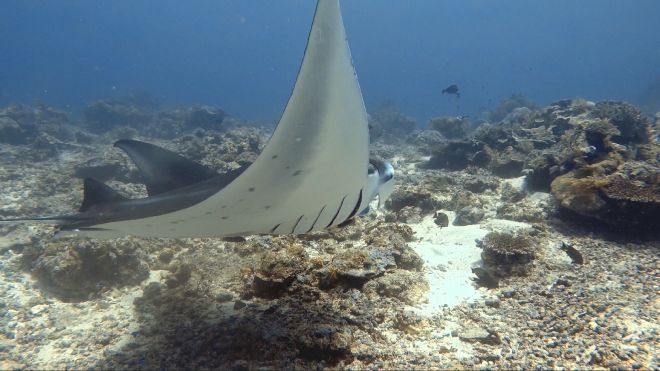
I guess that is the main attraction for most divers in Komodo. These graceful giants can be seen at cleaning stations, where they come to have parasites removed by smaller fish, as well as within multiple channels with varying strong currents.
Turtles

Green, loggerhead and hawksbill turtles are commonly seen resting on the reefs or swimming gracefully through the water. If you love turtles, I would recommend you to read also my trip report about diving in Marsa Alam.
Reef Sharks
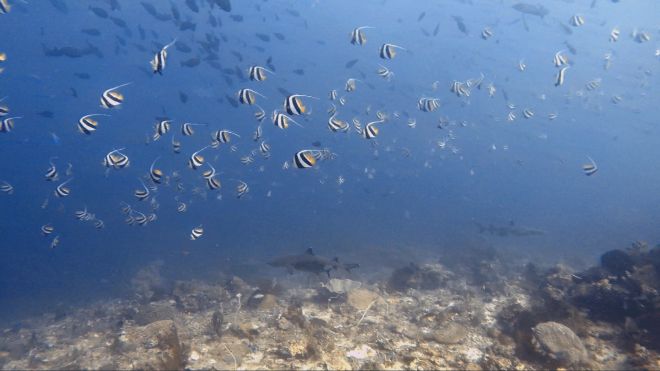
Black-tip, white-tip, and grey reef sharks are often spotted patrolling the reefs in search of their next meal.
Dolphins
Playful pods of dolphins can sometimes be seen riding the bow waves of boats or swimming alongside divers.
Whale Sharks
Though rare, these gentle giants have been known to make from time to time an appearance in Komodo’s waters.
The reefs themselves are teeming with countless species of colorful fish, such as schools of trevallies, barracudas, and fusiliers. Macro enthusiasts will also be delighted by the presence of critters like frogfish, ghost pipefish, and various species of shrimp and crabs. More information about marine life I will give you in my review of the best diving spots later in the article.
What Art The Best Komodo Dive Sites?
Komodo’s main diving spots can be divided into three main regions: the northern, central, and southern areas, each with its distinct characteristics and marine life.
During my unforgettable journey to this extraordinary destination, I had the opportunity to explore the northern and central regions of the park extensively. While I didn’t have a chance to delve into the southern area because of really bad visibility, I can assure you that the north and central regions alone offer a treasure trove of unforgettable underwater experiences.
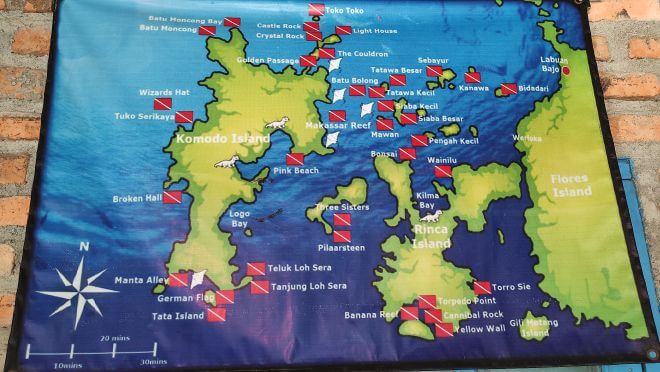
In the following section, I’ll be sharing my personal top eight Komodo dive sites in the northern and central regions of Komodo National Park. From coral gardens teeming with life to adrenaline-pumping drift dives that will leave you breathless, these sites represent the very best that Komodo has to offer. So, strap on your fins and join me as we embark on a journey through the stunning underwater landscapes of Komodo’s north and central regions!
1. Batu Bolong

Without any doubt, you cannot go to Komodo without diving in Batu Bolong, and in my opinion, it is absolutely one of the best dive sites in Komodo. Batu Bolong is a small island with often powerful currents and an abundance of marine life. Diving here typically follows one of two routes, depending on the current direction. Luckily, I was able to dive both ways during my trip.
During a falling tide, divers usually enter on the sheltered eastern side, encountering vast walls, crevices, and a seabed adorned with colossal fallen blocks. These spots are home to giant groupers, moray eels, Indian lionfish, turtles, and schools of tuna and trevally.
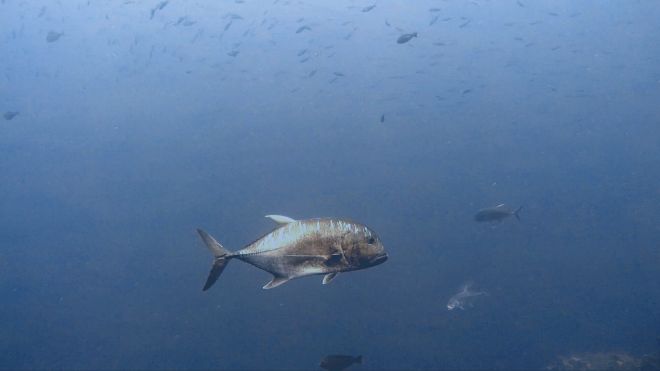
On a rising tide, the north side presents a magnificent wall and a series of spurs covered with impressive table corals and barrel sponge formations. Divers will find vibrant yellow and silver giant sweetlips, groupers, emperors, and coral trout among the spurs, as well as stunning gorgonian fans.
Both north and south sides teem with fish, as smaller species seek refuge from the current and larger ones are hunting them.
Diving at Batu Bolong is a zigzag from deep to shallow, offering an awe-inspiring experience with an abundance of marine life. As with most diving sites in Komodo, it is important to have an experienced dive guide as down currents that occur can be strong and demonstrate the fearsome power of the forces of nature. The dive can be up to 40m deep. However, even within the first 18m, you can explore most of the dive site. Therefore, as long as you follow the guide and turn around in time for the zigzag dive at the current edges, the dive site is also suitable for beginners and, thanks to its central location, also relatively quickly accessible (about 1.5h from Labuan Bajo).
2. Mawan

Mawan is a beautiful dive site located off the coast of Mawan Island within central Komodo. The site features a mix of coral gardens, sandy slopes, and seagrass beds, providing a diverse habitat for a wide variety of marine life.

Mawan is particularly famous for its manta ray sightings, as the gentle currents and abundant food supply create ideal conditions for these graceful giants. I can also confirm this with my own experience, as I was lucky to see here multiple manta rays during my dive. In addition to mantas, divers can also spot turtles, eagle rays, and an array of macro critters hiding amongst the corals and seagrass.
3. Castle Rock

Castle Rock is an underwater seamount located north of Gili Lawa Laut within the north part. The currents around Castle Rock attract various large fish species seeking food and shelter, transforming the seamount into a sanctuary teeming with life.
Divers often begin on the current side of the mount, drifting then towards the lee side. At depths of around 20-30 meters, it’s common to spot gray reef sharks, white tip sharks, and various schooling pelagic fish. If you are really into sharks, take a look at my trip report about diving in the North Ari Atoll.
Due to the often very strong currents, it may be necessary to use reef hooks. Although I would personally recommend the use of your own reef hook, the guides here also often have reef hooks with a 10m+ long line, which several divers can comfortably hold on to.
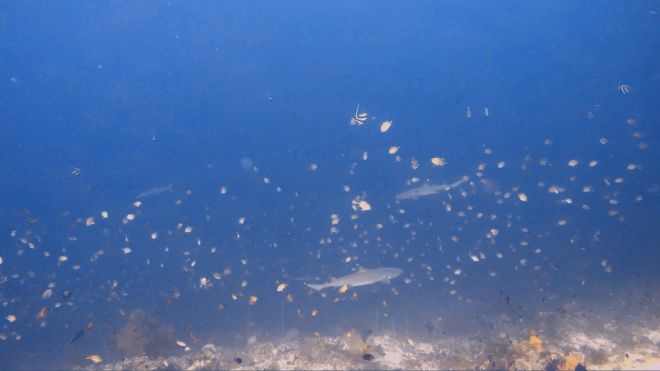
Castle Rock’s northern and southern slopes feature immense coral formations adorned with vibrant noble feather stars. Here, divers can find giant trevallies, jacks, groupers, emperors, and other large fish. Schools of surgeonfish create colossal black pinnacles while countless fusiliers, sweetlips, and snappers congregate in dense clusters. The branching corals also provide a home for multicolored wrasses, tobies, filefish, and gobies.
Macro life is abundant at Castle Rock, with a variety of nudibranchs, including the striking Blue Dragon, as well as shrimp and crabs hiding amongst the corals. The dive site leaves many divers exhilarated and cheering upon resurfacing.
The safety stop is usually conducted at the largest lake mountain, where divers can watch the breathtaking underwater show from a depth of 5 meters in the safe current shadow.
4. Crystal Rock

Crystal Rock is a large sea mount situated between Castle Rock and Gili Lawa Laut. Divers are captivated by the site’s stunning array of colors and abundant fish life, which offers a slightly different experience compared to Castle Rock.
At Crystal Rock, you’ll find yellow-ribbon sweetlips, surgeonfish, and anthias swimming around the vibrant, coral-covered rock formations. The northern walls of the site are adorned with soft corals and large fans, home to a variety of fascinating nudibranchs and flatworm species.
The northwest section of the site features a seamount extending from the main rock, forming a valley teeming with schooling fish. Look under the table corals for a chance to spot grouper, barramundi, and other intriguing rockfish species. Schools of eagle rays and devil rays have also been observed in this area. The mount itself is carpeted in vivid orange, yellow, red, and blue soft and hard corals, providing shelter for numerous fish species.
The southern side of Crystal Rock offers its own wonders, with remarkable coral formations and large fish dwelling in deeper waters. Here, you’ll find elkhorn coral, smaller mounts, and boulders offering sanctuary to a variety of marine species.

To conclude the dive, a three-minute safety stop at the three rocks is an excellent opportunity to observe morays, stonefish, crocodile fish, day octopus, and giant lionfish. Crystal Rock, together with Castle Rock, guarantees an extraordinary diving experience that will leave you in awe. However, from my own experience, I can tell you that the currents here can sometimes be really massive, and you might are not always able to reach the spots perfectly and hook yourself within the current.
5. The Cauldron

The Cauldron, also known as “Shotgun,” is a drift dive in the north featuring incredible topographical variations situated between Gili Lawa Laut and Gili Lawa Darat. The site is named after the bowl-shaped drop-off on its eastern end, resembling a Spanish cauldron or large bowl. Due to the water funneling through the passage between the islands, this dive can be intense, with currents sometimes reaching up to 10 knots!
The dive usually begins in lush coral gardens in the northwest or northeast, with a beautiful coral garden along a sandy bottom in the southwest. At around 10 meters, a large coral formation on a pinnacle attracts schools of colorful glassfish. Swimming through them is a mesmerizing experience.
Further into the channel, a large wall extends to a sandy bottom at about 30 meters. Here, you’ll find Gregorian coral and critter-filled fan corals. Larger fish, like bumphead parrotfish, take shelter in the wall’s overhangs, and you might even spot a turtle feeding nearby.
After the wall, you’ll navigate through the sandy patch with strong currents. Depending on your experience, you can either explore the canyon on the northwest side or a series of smaller canyons and reefs teeming with schooling fish and even mantas. The Canyon route is better suited for advanced divers and offers exciting encounters with large fish species as well as some spots to set a reef hook. Tuna, barracuda, sharks, and manta rays. I was again very lucky here and we could be fixed with a reef hook in the “shotgun” area and let the current hit our face while watching sharks, manta rays, and tuna.
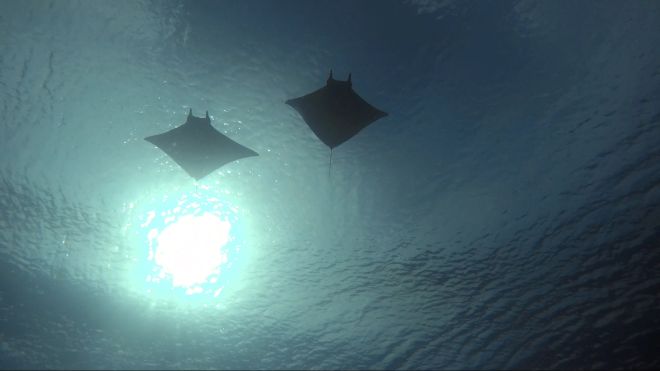
On the eastern side, the Cauldron’s slope deepens to 12 meters, leading to a large sandy bowl filled with colorful coral patches and diverse fish life. Garden eels, stingrays, and even sharks can be spotted here. The dive concludes in a stunning coral garden, abundant with turtles, macro life, and vibrant colors.
6. Golden Passage

Golden Passage, our fourth dive site in the north, is a captivating dive site nestled between Komodo and Gili Lawa Laut islands, boasting a dynamic underwater landscape and an incredible array of marine life. As its name suggests, this dive site is a veritable treasure trove of vibrant corals, fish, and unforgettable diving experiences.
The site features a mixture of soft and hard corals, forming a spectacular underwater garden that stretches along the sea floor. The topography is characterized by sloping reefs, a series of ridges, and a channel where divers can navigate the exciting currents.
One of the main highlights of Golden Passage is its diverse fish population. Divers can encounter large schools of fusiliers, trevallies, and snappers that dart through the water in mesmerizing formations. Colorful anthias and butterflyfish flit among the corals, while larger predators such as white and black-tip reef sharks patrol the area.
The site is also a haven for macro enthusiasts, who will delight in discovering an assortment of nudibranchs, crustaceans, and other small critters hiding within the coral structures. The sandy areas between the coral formations are home to garden eels and stingrays, which can be observed gracefully gliding along the sea floor.
Golden Passage is also known for its pelagic encounters. Divers may have the opportunity to spot majestic manta rays, eagle rays, and even the occasional whale shark cruising through the nutrient-rich waters. During one of my dives in the Golden Passage I was again very lucky and saw a school of 36! Manta rays for over 25 minutes! Where was I allowed to experience this? Of course, again in the middle of the current! We drifted quite fast in the channel and fortunately, our small group reacted quickly and we were able to set our reef hooks close to the school of manta rays. Just to give you an idea, the current was so strong that you didn’t even get a meter against the current! All of this also happened on the second last dive of the tour and was therefore an absolutely “golden” conclusion!

With its vibrant marine life and fascinating underwater landscape, Golden Passage offers divers an unforgettable experience. It’s an excellent choice for intermediate to advanced divers due to its currents and varying depths. This diving site is sure to leave a lasting impression, making it a must-visit destination for any diving enthusiast exploring the Komodo region.
7. Manta Point
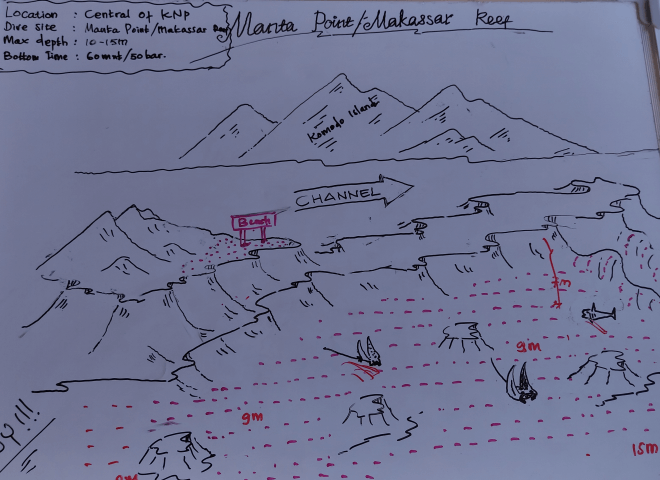
Manta Point, affectionately known as Kurang Makassar when the elusive mantas decide to play hide-and-seek with divers, is a breathtaking dive site located off the east side of Komodo Island within the central area. This popular spot is famous for its congregation of majestic manta rays that frequent the area due to the long current-swept reefs running north to south. These reefs create a feeding ground and highway for the graceful mantas, making it a must-visit site for any diver exploring Komodo National Park. But remember, if you’re lucky enough to spot these magnificent creatures, it’s Manta Point; otherwise, you might find yourself jokingly referring to it as Kurang Makassar.
The dive site is typically a drift dive with moderate to heavy currents, providing a relaxing underwater journey along the fascinating coral reefs. Divers will descend to depths of 12 to 14 meters, where they’ll find a series of broken coral reefs interspersed with larger coral bommies. These bommies offer shelter to mantas during heavy currents, where they can be seen effortlessly gliding through the water while feeding on plankton.
Depending on the current, it can sometimes be difficult to set a reef hook here and stay with “found” manta rays. However, in moderate currents, this is not a problem. Please keep enough distance to the manta rays and try to stay as close to the bottom as possible. The playful manta rays will thank you with a longer presence and possibly a few extra rounds through your bubbles.
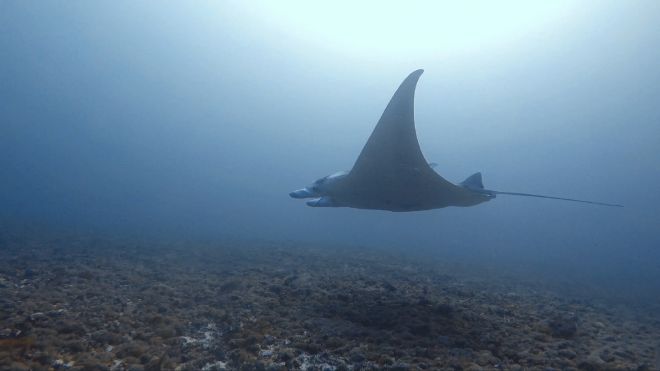
In the event that mantas are not present, Manta Point still offers a wealth of marine life to enjoy. The coral reefs provide a habitat for sweetlips, emperors, white-tip sharks, and more. Mantis shrimp can be found hiding in rocks and crevices, showcasing their vibrant colors and unique behavior. However, exercise caution around these fascinating creatures, as their powerful appendages can strike with incredible speed.
Additional marine life at Manta Point includes moray eels, clown triggerfish, filefish, unicorn fish, and schools of fusiliers. With so much to see and experience, Manta Point is sure to be one of the most unforgettable dives in the park.
Manta Point is also frequently visited by day trips to Komodo National Park for snorkeling. Usually, the boat crew then looks for manta rays close to the surface and lets the guests quickly jump into the water in case of a sighting.
8. Pink Beach
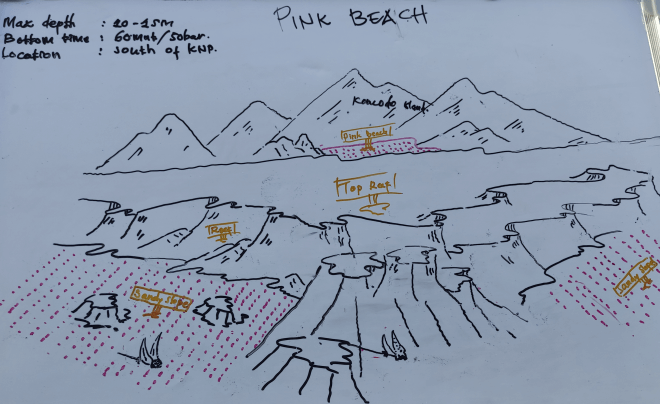
Last but not least, Pink Beach is a mesmerizing dive site located near Komodo Island, known for its distinctive rosy-hued sands and vibrant underwater world. This unique beach gets its pinkish hue from the mixture of white and red sand, which creates a picture-perfect setting for a memorable dive experience.
The underwater realm at Pink Beach offers a diverse marine ecosystem, teeming with a wide variety of fish and coral species. Divers can explore the gently sloping reef, which begins just a few meters from the shore and extends to around 25 meters in depth. With its calm waters and mild to moderate currents, this site is perfect for divers of all experience levels, including beginners and snorkelers.
As you descend beneath the surface, you’ll be greeted by a kaleidoscope of colorful corals, including both hard and soft varieties, which provide shelter and sustenance for an impressive array of marine life. You can expect to encounter schools of vibrant reef fish, such as butterflyfish, angelfish, and parrotfish, as well as larger species, like groupers and barracudas.
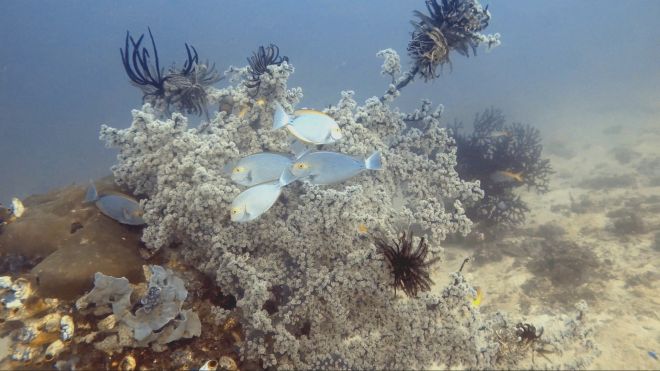
Pink Beach is also a haven for macro enthusiasts, with many small and fascinating creatures hiding among the corals. Keep an eye out for nudibranchs, seahorses, pipefish, and various species of shrimp and crab, as well as the elusive octopus and cuttlefish.
As you explore the dive site, don’t forget to take a moment to appreciate the breathtaking topography, which features a combination of coral gardens, sandy patches, and rocky formations. These diverse habitats attract an array of pelagic species and even the occasional shark or manta ray passing by.
After completing your dive, take some time to relax and soak in the surreal beauty of Pink Beach. It is a one-of-a-kind landscape, and the vibrant underwater world makes it a must-visit destination for any diver venturing into the Komodo National Park.
In summary, the dive sites in Komodo National Park offer a truly diverse and captivating underwater experience. While each site has its unique attractions, it’s essential to remember that every dive can be different, and conditions can vary greatly. During my trip, I’ve dived many of these spots multiple times, and I can attest to the vast differences between dives – from seemingly mundane to utterly spectacular. The unpredictability of the underwater world is in my opinion part of the charm and fascination of diving in Komodo, ensuring that every dive is a new adventure waiting to be explored.
Day Trips Or Diving Safaris?
When considering diving in Komodo National Park, you have two main options: day trips or diving safaris (liveaboards). Day trips require quite a bit of travel time, taking around 1.5 hours to reach central Komodo dive spots and even up to 2,5 hours to reach the northern dive sites. In contrast, liveaboards eliminate this transfer time, allowing you to make the most of your diving experience.
On a liveaboard, you’ll often be the first to arrive at dive spots in the morning, which is a great advantage over the numerous day boats. Moreover, you usually see all the top dive spots within a shorter period of time, and you can experience wonderful evenings and nights on the water.
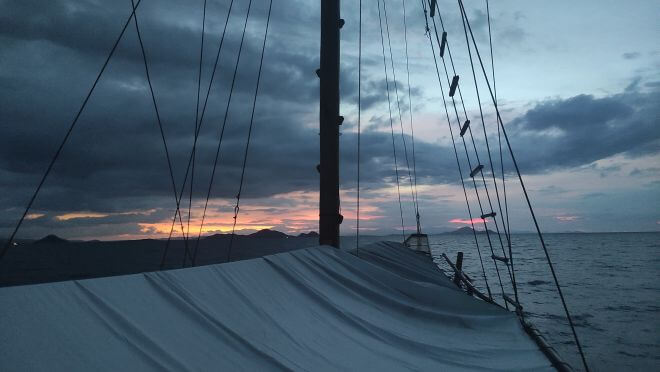
However, keep in mind that most liveaboards have engines that run throughout the night, which can sometimes be noisy and might affect your relaxation, especially when you have a light sleep. For me personally, however, this was not a problem and on one safari boat, in consultation with the other guests, the air conditioning system and thus the generator was not running during the night.
In terms of dive site variety, Komodo diving day trips tend to have shorter notice planning, which could result in visiting many of the same spots and potentially missing out on others. Day trips are also less likely to explore the northern or southern regions of Komodo, as they mainly focus on central Komodo, but they offer more flexibility in terms of scheduling and are generally more affordable (see more about the prices in the next paragraph).
In summary, if you plan to dive for more than two days, I will personally recommend opting for a diving safari, as you will already find many offers starting with a duration of 3 days. This option allows for a more comprehensive and flexible diving experience, making the most of the stunning underwater world that Komodo National Park has to offer.
How much is Diving in Komodo?
Diving costs in Komodo National Park can vary depending on the type of trip you choose. For day trips, which usually include three dives, the cost ranges from $140 to $180, with little to no price difference between trips with or without equipment. By the way, nitrox is rarely available in this area, and if it is, there will definitely be extra costs associated with it.
For multi-day diving safaris, prices start at roughly $200 per day and increase from there. The cost of a safari is mainly influenced by the level of luxury and amenities you desire.
At first glance, diving safaris appear to be more expensive compared to day trips. However, when you take a closer look, particularly at safaris in the lower price range, the overall costs are not that different. When you factor in the cost of day trips and add hotel expenses, the total amount can be similar to or even higher than the cost of a diving safari. That is for me, besides the other mentioned benefits before, another reason why I recommend a diving safari on a liveaboard if you plan to spend more than two days. There are plenty of short safari tours, starting from only three days available.
What Should You Do in Komodo Besides Diving?
While Komodo National Park is primarily known for its world-class diving, the area also offers a variety of other activities and experiences for visitors to enjoy. Here are some exciting things you can do in Komodo, aside from diving:
1. Komodo Dragons
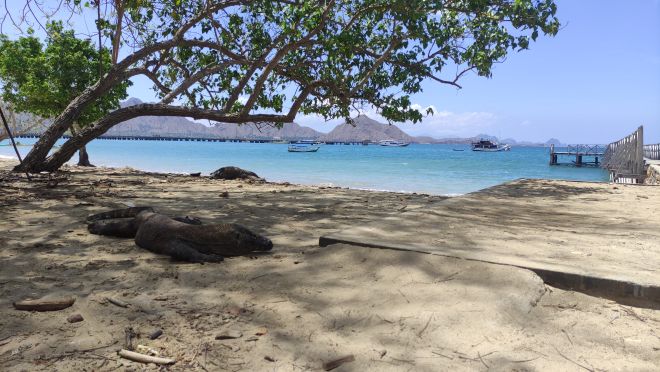
No journey to Komodo National Park is truly complete without a rendezvous with the world’s most massive lizards – the Komodo dragons. Traverse the raw terrain of Komodo Island under the watchful eyes of park rangers as they escort you through the dragons’ dominion, revealing the secrets of these awe-inspiring reptiles and the delicate balance of their ecosystem.
2. Pink Beach
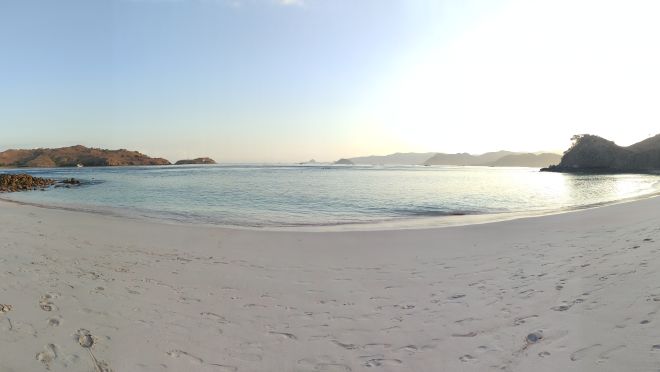
Not simply a haven for divers, the Pink Beach captivates visitors above the waves as well. The enchanting, rosy sands – born from a marriage of white sand and pulverized red coral – beguile the senses. Unwind on this mesmerizing beach, bathe in the crystalline waters, or snorkel amidst the teeming, vivacious coral reef just a stone’s throw away.
3. Hiking and Trekking
Embrace Komodo National Park’s untamed beauty through an array of hiking and trekking adventures. Serpentine trails offer awe-inspiring panoramas of the islands and seascape, like the popular ascent of Padar Island, where the summit reveals a vista of three stunning bays below.
4. Snorkeling
Delve into the stunning marine world without donning diving gear. Snorkeling affords an exhilarating glimpse into Komodo National Park’s aquatic wonders. Many renowned dive sites, such as Pink Beach or Mawan, also provide snorkelers access to shallow depths, vivid coral gardens, and a cornucopia of fish life.
5. Local Cultural Experiences

Immerse yourself in the rich cultural tapestry of the region by visiting communities like Komodo Village or Rinca Village. Engage with amicable locals, bear witness to traditional dance performances, peruse handcrafted souvenirs, and develop a profound appreciation for the area’s cultural heritage.
Komodo National Park’s appeal extends far beyond its illustrious diving. From thrilling encounters with Komodo dragons and picturesque hikes to vibrant coral reefs and cultural immersion, this multifaceted destination holds something for every intrepid traveler. And, for those embarking on diving safaris, rest assured, experiences such as Komodo dragon visits, Pink Beach exploration, and hiking adventures are often woven into your itinerary!
Some Final Tips For Diving In Komodo
I hope my article has given you a good impression of what to expect from a Komodo diving trip. Enclosed are some final tips to help you make the most of your diving experience in Komodo:
- Choose the right season: Consider the different Komodo diving seasons and decide which season/month fits best your need. For the reasons mentioned earlier, I can totally recommend September.
- Get comfortable with drift diving: To get the most out of your diving trip, ensure you’re confident in your drift diving abilities. Strong currents are common in Komodo. If you like drift diving, Komodo is the place to go!
- Book with the right diving school: Do your research and make sure to book with a well-reviewed diving school. Make sure to contact them early on and describe your expectations and special needs.
- Bring the right equipment: If you decide to dive with your own equipment, don’t forget to bring a reef hook and a surface marker buoy (SMB) to help you manage the currents.
- Stay hydrated: The currents in Komodo can be extremely physically demanding. Therefore, it is even more important here to drink enough water!
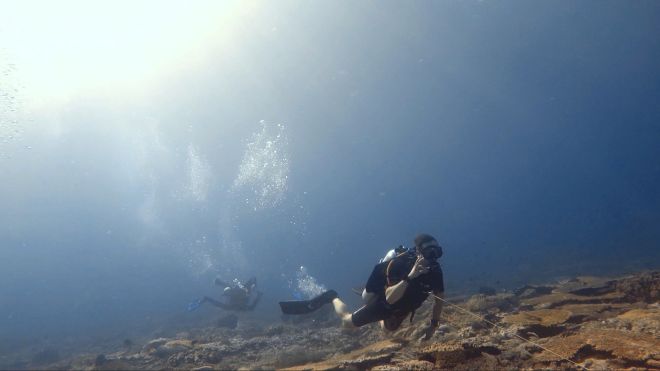
In conclusion, a Komodo diving trip is an extraordinary experience that offers some of the world’s most diverse marine life and stunning underwater landscapes. Whether you choose day trips or liveaboards, be prepared for challenging currents and unforgettable encounters with manta rays. With careful planning and the right partner, your scuba diving Komodo adventure will be one you’ll treasure for a lifetime. Remember, it’s essential to be aware of the challenges and unique conditions that Komodo presents, but with the proper preparation and mindset, you’ll undoubtedly have a life-changing experience – just like me!

